The Great Depression & WW II
War at Sea
Control of the ocean was important to the United States, which had oceans on both sides between itself and its enemies.
Many American battleships had been severely damaged or destroyed in the attack on Pearl Harbor, leaving the Pacific fleet weakened.
In the Atlantic Ocean, German submarines patrolled the shipping lanes between the U.S. and England. They hunted in packs, launching torpedoes towards unsuspecting ships. In early 1942, the Germans sank 680 Allied ships, sending their cargo and many of their men to the bottom of the sea.
Again, American industry stepped in and built more ships. With improved submarine detection systems, Allied forces were able to gain control of the Atlantic by 1943. The Allies were now able to safely ship troops and supplies needed for the liberation of Europe.
It was fortunate that U.S. aircraft carriers had not been at Pearl Harbor on December 7, 1941. With its aircraft carriers and their onboard airplanes, the U.S. was able to defeat the Japanese fleet at the battles of Coral Sea and Midway in 1942. With these victories, the U.S. gained a major advantage over the Japanese. By 1944, the U.S. Navy controlled the Pacific Ocean.
Even with control of the ocean, U.S. ships and men were still exposed to a new danger—suicide attacks by Japanese pilots, called Kamikaze. Loaded with bombs and fuel, the pilots attempted to fly their airplanes into U.S. ships. If the pilot made a direct hit, there was a huge explosion which could sink the ship.
Being in the Navy was somewhat different than serving in other service branches. Sailors spent both on and off duty time on their ships. Life could be boring when there was no enemy around. Sailors might play poker games to pass the time.
Read an account of what everyday life was like on the battleship North Carolina during World War II.
Being under attack was frightening. The worse, according to one sailor, was a night attack.
There's nothing worse than a night torpedo plane attack in my opinion. This is because they see your wake in the water….and they can see where you're going.
You couldn't tell where they were except when they went over you and you could see the exhaust….You could hear, but you never knew just where they were….When you've got outgoing gunfire, it's like lightning. You don't know which direction it's coming from, it goes either way. With all your 20 guns going out, there's a flash and it looks like its comin' right at ya'. It's a scary thing.
You couldn't tell where they were except when they went over you and you could see the exhaust….You could hear, but you never knew just where they were….When you've got outgoing gunfire, it's like lightning. You don't know which direction it's coming from, it goes either way. With all your 20 guns going out, there's a flash and it looks like its comin' right at ya'. It's a scary thing.
Picture Credits:
- Men on the deck of the US Coast Guard Cutter Spencer watch the explosion of a depth charge which hit a German U-Boat (submarine). The submarine, called U-175, eventually sank. Ships lobbed charges into the water set to explode at a certain depth. If a submarine was near the explosion, it could be damaged or destroyed. National Archives
- Living quarters were cramped aboard submarines. These sailors' bunks were beside and above two torpedoes. U.S. Navy
- A torpedoed Japanese destroyer is sinking below the waves. This photograph was taken through the periscope of the U.S. submarine. U.S. Navy
- The USS Hornet's 40mm guns fire on Japanese ships in February 1945. Notice the empty shell casings beneath the guns. National Archives
- Sailors often kept totals of the number of enemy ships they sank on a naval scoreboard. Here, on the USS Griffin, a sailor paints another Japanese ship on their list. According to their board, they have sunk 11 Japanese ships. The photograph is dated January 1943. U.S. Navy photograph now in the National Archives
- To replace the ships lost at Pearl Harbor, the American shipbuilding industry worked overtime. Notice the number of workers building this ship in September 1942. Franklin D. Roosevelt Library
- The USS Iowa fires her 16-inch guns in the Pacific Ocean during 1944. Life Images
- The USS Wahoo submarine heads out of the Mare Island Navy Yard in California on July 14, 1943. The ship entered the Sea of Japan in September of 1943 and was never heard from again. Historians later figured out from Japanese naval records that the Wahoo had sunk four Japanese ships before being sunk herself on October 11, 1943. In 2006, a Russian dive team looking for a Soviet sub lost in World War II photographed the wreck of a submarine which was later identified as the Wahoo. The U.S. Navy has a tradition that sailors lost at sea remain at sea, so there are no plans to salvage the wreck. During World War II, the Navy lost 52 submarines with nearly 3,600 men. National Archives
- With the staggering losses of trained Japanese pilots in 1942 and 1943, untrained replacements volunteered for suicide crashes into American warships. These attacks, called Kamikaze, were usually very destructive. Here a kamikaze pilot takes aim at the USS Missouri on April 11, 1945. The pilot hit too low, only causing a dent in the side of the ship and no casualties among the ship's crew. U.S. Navy
- A Kamikaze attack on the USS Bunker Hill was deadly, as 372 sailors died when two Japanese airplanes hit the ship in 30 seconds on May 11, 1945. In this photograph some sailors watch as others fight the fires. U.S. Navy photograph at the National Archives
- Dive bombers from the USS Hornet go in for another attack on the burning Japanese ship Mikuma during the Battle of Midway in June 1942. The ship eventually sank. U.S. Navy photograph now at the National Archives
The Great Depression & WW II >> World War II >> Fighting the War >> War at Sea
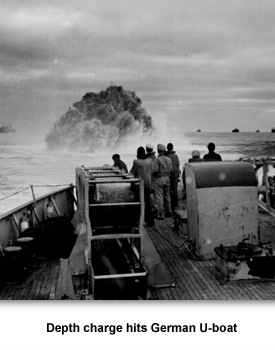
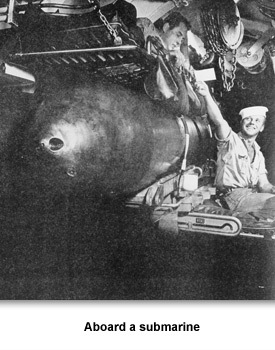
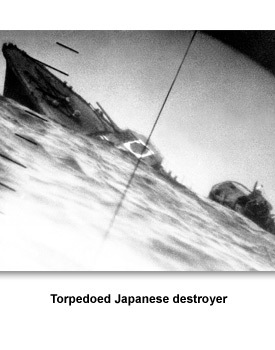
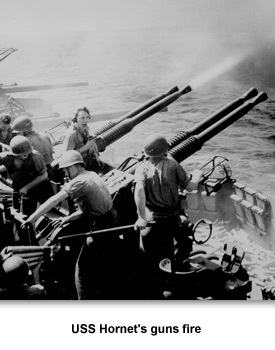
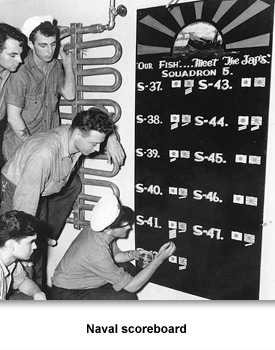
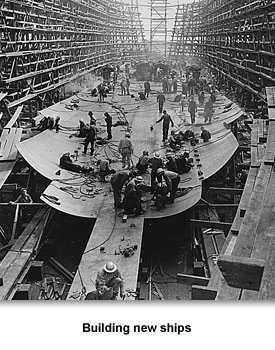
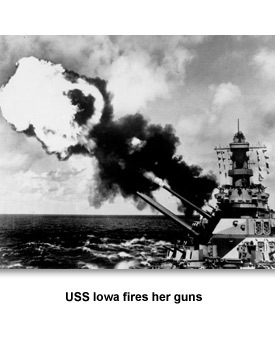
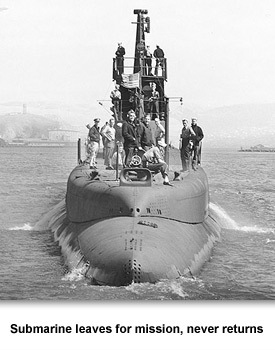
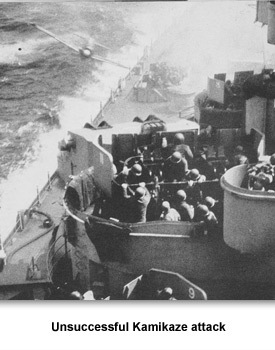
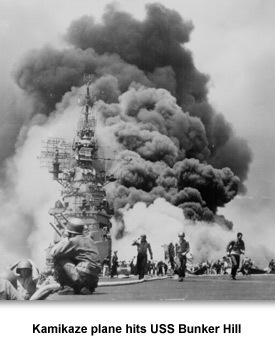
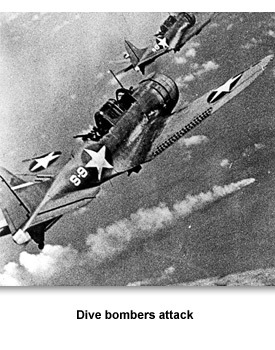
 Sponsored by: National Endowment for the Humanities
Sponsored by: National Endowment for the Humanities